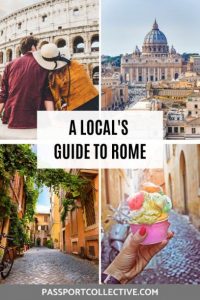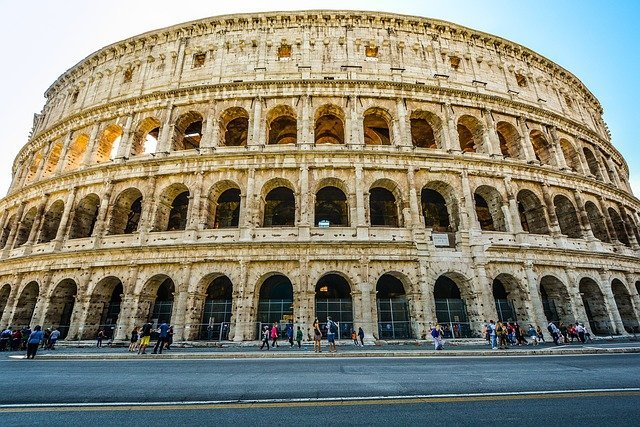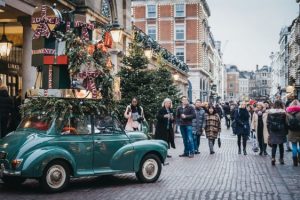If you’ve not been to Rome yet, then you may already feel like you have been. It is such a popular city and has been documented widely on the internet. I would say it is one of the most Instagrammable city in Italy.
Before we visited we knew of all of the major sites. The Trevi Fountain, the Spanish Steps, the city is packed with iconic landmarks. Some people sigh and think ‘ahh Rome it is soooo touristy’. Well, yes and no.
Firstly, you need to be selective about the time of year you visit. We recommend mid Autumn and Spring. Winter is too cold and Summer, well, good luck with the crowds! Secondly, it helps to have a local to show you around.
Wait, you don’t have one of those? Well you’re lucky because we did and we’re about to show you how to visit Rome with a local.
OUR ONE DAY ROME WALKING GUIDE

Get around Rome on the metro
Hey, good morning. I hope you’re up early because we have a big day ahead of us. It all starts with a trip on the Metro. We’re getting on at Spagna, but you can get on at any stop. We’re heading to Piramide, which is on the B or the blue line.
Like us, you may need to swap lines (we swapped at Termini, which is the main station in Rome). Never fear, the Rome Metro is easy to navigate and the colour coding makes it easy to find the right line.
TOP TIP | Sadly Rome is rife with pickpockets. Find out how to keep your valuables safe with a zippered travel scarf.

First Stop: Piramide
You may be lucky enough to have a busker to make your train ride more enjoyable. We were quite impressed to see a lady set up her microphone and speakers in our carriage. Talk about a captive audience!
If your Italian is good, you may have already worked out why the station is called Piramide, but if not, it’ll soon become apparent to you as you walk out of the station. Once at street level, you will be greeted with a 36.4 metre high Pyramid. Not a replica, not a memorial or an art instalment, but a genuine pyramid. I bet you weren’t expecting this. Let’s go and check it out.

Exploring the cemetary & pyramid
The pyramid is located towards the back of the cemetery, so why not take a look around. The cemetery is the burial place of the famous English poet John Keats, and his modest grave can be found in the grassy area through the arch to the right of the entrance. Other notable graves include William Wetmore Story, an American sculptor, known for his haunting sculpture, theangel of grief, which was crafted as a monument for his wife’s grave.
Once you’ve finished exploring the cemetery and perhaps patting one of the many cats who calls it home, head over to enjoy the Pyramid.
The Pyramid of Cestius is one of the best preserved ancient buildings in Rome. Built in around 18-12BC as tomb for Gaius Cestius, an important member of religious administration of the time. Unfortunately the tomb was plundered during ancient times, however when it was opened in the 1600s frescoes were visible on its walls. In 2015, restoration works were completed and the pyramid is now open for visits on Saturday’s between 10-2.
The cemetery and exterior of the pyramid are free to view, however it is recommended to donate a couple of Euros into their donation box to help fund maintenance works on your way out.

The Aventine keyhole
Once you’ve finished exploring the cemetery, head on up the hill to Aventine Hill. Its not well signed, so check your route before you start walking. Once you reach the crest of the hill you may wonder what all of that walking was for. Unless you arrive very early in the morning, or later in the day, all you will see is a truck selling refreshments / souvenirs and a large fancy door with a line.
It began to pour down with rain as we were waiting so I was a little distracted as to why the line was getting smaller. I figured that people were going through the gate, however as I got closer I realised they were spying through the peephole.
READ | You’ll need comfy shoes with all of the walking you’ll be doing. Read our guide to packing for a weekend away in Europe.
Lean in close and peep in through the hole and you will be rewarded with a fantastic view of an arched arbour with a perfectly centred view of St George’s cathedral in the middle. Talk about a surprise. Whilst the view is quite small, the long optical nature of the arched trees combined with the distance of the cathedral make for an optical delight.
To the right of the door is a beautiful Orangery and look out over the city that you can enjoy without peeking! Next door to the peep hole is the Giardina degli Aranci which gives you an unencumbered view of the city below and is also a fantastic place to see the sunset in Rome.

Onwards to the Colosseum
By now your appetite for Rome has been whet and I bet that you hanging to see the Colosseum. Hang tight, because we have a quick stop before and I promise that you’ll like it.
Its an 850 metre walk to our next stop and it’ll take you about 10 minutes. Unlike our last walk, this one is down hill and gives a great view of the back of the Colosseum as you walk.
READ | Love Roman ruins? Read our guide to visiting an incredible Roman amphitheatre in Lyon.

The mouth of truth
The mouth of truth is a roman ruin of a man’s head. With a wide open mouth, the story goes that if you put your hand in his mouth he will bite you if you are a liar. I’ve yet to see him bite anyone, but are you willing to try your luck?
After this short side stop and photo opportunity we are Colosseum bound.

The Colosseum
You’ll be feeling your excitement levels rising by now. You’re on your way to the Colosseum. Its a 1.5k walk, so make sure your walking as the magnificent structure that is the Colosseum looms above you, you’ll likely be walking along with your head raised high peering up at this magnificent structure.
If you like, take a tour and see the inside. You can also come back and view the Colosseum at night under lights. There is a Metro station just opposite the Colosseum, so you can easily return without all of the walking.
READ | Our guide to Roman ruins in The Cotswolds, England.
Once you’ve explored and taken your photos, you’ll be feeling quite peckish. Choose from one of the bars overlooking the Colosseum, or one of the many trattorias nearby. You are spoilt for choice when in Rome.
A local’s tip is to never eat at a restaurant that has pictures of the food on a board of the restaurant. You won’t find the best Italian food here, instead look for somewhere a little off the main tourist roads and you’ll be eating more like a local.

San Pietro in Vincoli
Built in the 5th century, San Pietro in Vincoli was built to hold the relic of chains that bound Saint Peter when he was held in Jerusalem. It also houses Michelangelo’s statue of Moses, which was created in around 1515.
The church itself is quite simple, with a spectacular painted ceiling above the altar. Other sculptures on the walls depict images of saints as well as a macabre rendition of the angel of death. Whilst not as ornate as many of the Roman churches, its large cavernous size, and relatively quiet nature means that it is truly a wondrous site to behold.
As it is located so close to the Colosseum, it is certainly worth a visit and is on our way to our next and second last stop which is an easy 20 minute walk away.
READ | Love cathedrals? Read our guide to the best cathedrals in the UK.
The Forum of Cesar
Whilst there are many ruins to see within the city, The Forum of Cesar, is such a detailed site it is well worth the village. In around 54 BC Cesare began the construction of a forum on this rather expensive pocket of land. It is believed that the site was completed by Augustus.
In addition to the forum the site also holds ruins of Cesar’s temple amongst other buildings. Whilst we are having a look over the site from the viewing area, if you’ve got a bit more time, you can buy a ticket and enjoy the ruins from ground level.

The last stop: Piazza Venezzia
Its been a long and exciting day of exploring, so I’m going to take you to one more place before we head back onto the Metro and you can relax for a while in your hotel.
Located directly next to the Foro di Cesare lies the Piazza Venezia.
Whilst its not a favourite amongst many Romans due to its style being out of keeping with its ancient neighbours, it is impressive none the less.
Ascend the stairs to get a good view of the square or if time permits, have a look inside. By this time, your legs will surely be weary so it’s time to head back to the Metro and head back to your hotel for a little R&R before you head back out at night.
Our tour for the day is over, but we recommend you do have a rest break and head back out at night as the city is well lit and many of its attractions such as the Colosseum and the Trevi Fountain are spectacularly lit up at night and well worth a look.
READ | Our guide to planning a weekend away in Europe.







